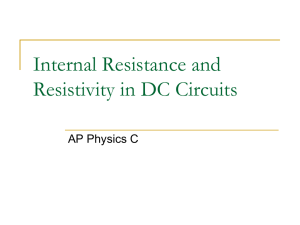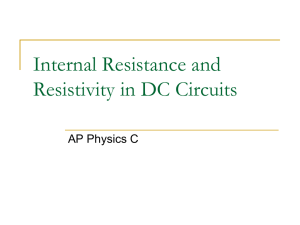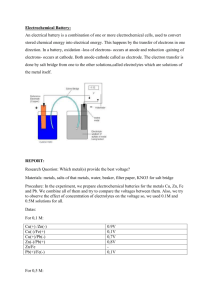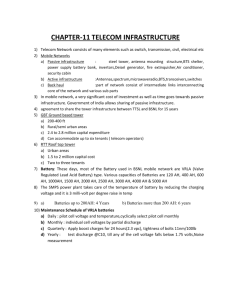hw05_solutions
advertisement
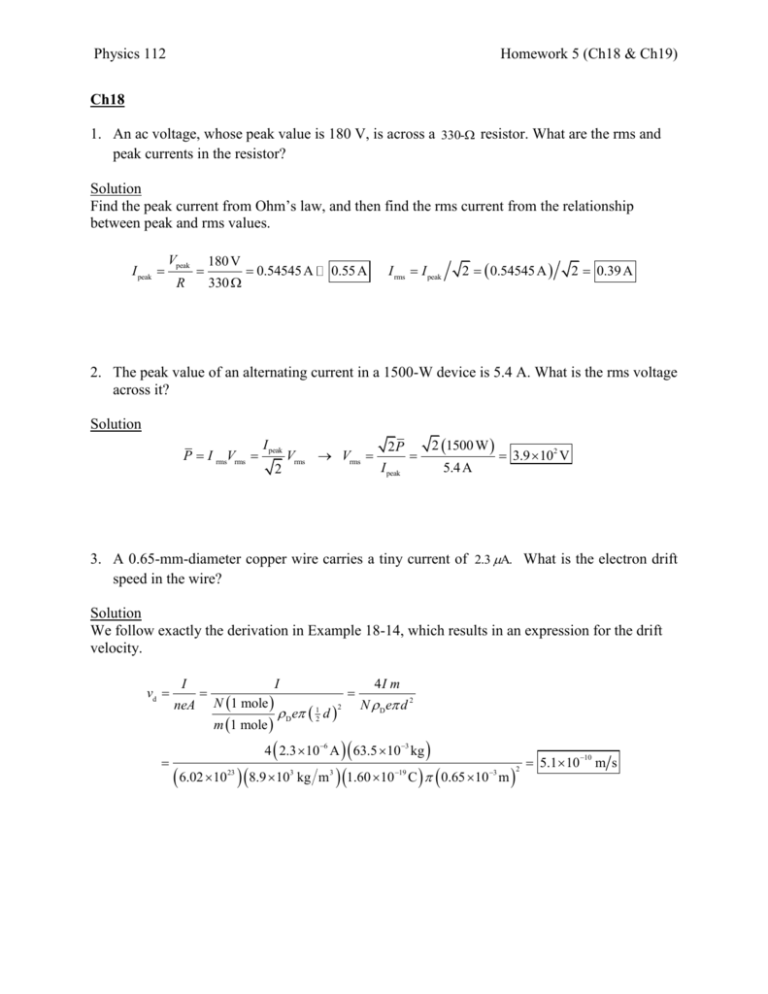
Physics 112 Homework 5 (Ch18 & Ch19) Ch18 1. An ac voltage, whose peak value is 180 V, is across a 330- resistor. What are the rms and peak currents in the resistor? Solution Find the peak current from Ohm’s law, and then find the rms current from the relationship between peak and rms values. I peak Vpeak R 180 V 330 0.54545 A 0.55 A I rms I peak 2 0.54545 A 2 0.39 A 2. The peak value of an alternating current in a 1500-W device is 5.4 A. What is the rms voltage across it? Solution P I rmsVrms I peak 2 Vrms Vrms 2P I peak 2 1500 W 5.4 A 3.9 102 V 3. A 0.65-mm-diameter copper wire carries a tiny current of 2.3 A. What is the electron drift speed in the wire? Solution We follow exactly the derivation in Example 18-14, which results in an expression for the drift velocity. vd I neA N 1 mole m 1 mole I D e 12 d 2 4I m N D e d 2 m 1.60 10 4 2.3 10 6 A 63.5 10 3 kg 6.02 10 8.9 10 23 3 kg 3 19 C 0.65 10 m 3 2 5.1 1010 m s Physics 112 Homework 5 (Ch18 & Ch19) Ch19 4. Calculate the terminal voltage for a battery with an internal resistance of 0.900 and an emf of 8.50 V when the battery is connected in series with (a) an 81.0- resistor, and (b) an 810- resistor. Solution The current in the circuit is I (a) Vab IR R Rr E Rr . , or R 81.0 E E R r E r E 8.50 V 8.41V r Rr Rr 81.0 0.900 Rr Vab E Ir E (b) Vab E R Rr 8.50 V 810 810 0.900 8.49 V 5. What is the internal resistance of a 12.0-V car battery whose terminal voltage drops to 8.4 V when the starter draws 75 A? What is the resistance of the starter? Solution: Use equations for terminal voltage: E Vab 12.0 V 8.4 V Vab E Ir r 0.048 I Vab IR R Vab I 8.4 V 75 A 75 A 0.11 6. Calculate the current in the circuit of the figure below and show that the sum of all the voltage changes around the circuit is zero. Solution: All of the resistors are in series, so the equivalent resistance is just the sum of the resistors. Use Ohm’s law then to find the current, and show all voltage changes starting at the negative pole of the battery and going counterclockwise. I E 9.0 V 0.409 A 0.41A 8.0 12.0 2.0 voltages 9.0 V 8.0 0.409 A 12.0 0.409 A 2.0 0.409 A Req 9.0 V 3.27 V 4.91V 0.82 V 0.00 V Physics 112 Homework 5 (Ch18 & Ch19) 7. What is the potential difference between points a and d in the figure below (the same circuit as Fig. 19–13, Example 19–8 in the textbook), and (b) what is the terminal voltage of each battery? Solution From Example 19-8, we have I1 0.87 A , I 2 2.6 A , I 3 1.7 A . If another significant figure had been kept, the values would be I1 0.858 A , I 2 2.58 A , I 3 1.73A . We use those results. (a) To find the potential difference between points a and d, start at point a and add each individual potential difference until reaching point d. The simplest way to do this is along the top branch. Vad Vd Va I1 30 0.858 A 30 25.7 V Slight differences will be obtained in the final answer depending on the branch used, due to rounding. For example, using the bottom branch, we get the following. Vad Vd Va E1 I 2 21 80 V 2.58 A 21 25.8 V (b) For the 80-V battery, the terminal voltage is the potential difference from point g to point e. For the 45-V battery, the terminal voltage is the potential difference from point d to point b. 80 V battery: Vterminal E1 I 2 r 80 V 2.58 A 1.0 77.4 V 45 V battery: Vterminal E2 I 3 r 45 V 1.73 A 1.0 43.3 V 8. The RC circuit has R 6.7 k and C 3.0 F. The capacitor is at voltage V0 at t 0, when the switch is closed. How long does it take the capacitor to discharge to 1.0% of its initial voltage? Physics 112 Homework 5 (Ch18 & Ch19) Solution The voltage of the discharging capacitor is given by VC V0 e t RC . The capacitor voltage is to be 0.010V0 . VC V0 e t RC 0.010 V0 V0 e t RC 0.010 e t RC ln 0.010 t RC t RC ln 0.010 6.7 10 3.0 10 6 F ln 0.010 9.3 10 2 s 9. An ammeter whose internal resistance is 63 reads 5.25 mA when connected in a circuit containing a battery and two resistors in series whose values are 750 and 480 . What is the actual current when the ammeter is absent? Solution The total resistance with the ammeter present is Req 1293 . The voltage supplied by the battery is found from Ohm’s law to be Vbattery IReq 5.25 103 A 1293 6.788 V . When the ammeter is removed, we assume that the battery voltage does not change. The equivalent resistance changes to Req 1230 , and the new current is again found from Ohm’s law. I Vbattery Req 6.788 V 1230 5.52 10 3 A




